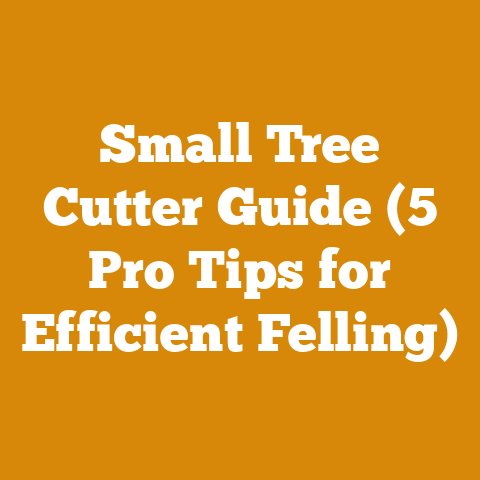Pruning Sealer Alternatives for Tree Wounds (5 Expert Tips)
Okay, here we go.
I’ve always found it a bit ironic that we spend so much time carefully pruning our trees to keep them healthy and beautiful, only to then slather on some gooey sealant that looks like something out of a horror movie.
It’s like performing delicate surgery and then patching it up with duct tape.
For years, the conventional wisdom was that pruning sealers were essential for protecting tree wounds from disease and decay.
But is that really the case?
Are we doing more harm than good?
Pruning Sealer Alternatives for Tree Wounds: 5 Expert Tips
Key Takeaways:
- Pruning sealers are often unnecessary and can even be harmful. Natural healing is usually the best approach.
- Proper pruning techniques are crucial. Clean cuts that promote rapid callus formation are key.
- Healthy trees are more resistant to disease and decay. Focus on overall tree health.
- Consider alternatives like natural tree wound treatments. Some options can aid the healing process without trapping moisture.
- When in doubt, consult with a certified arborist. They can provide expert advice tailored to your specific situation.
In this article, I’ll delve into the world of pruning sealers, debunk some common myths, and explore effective alternatives for promoting healthy tree wound healing.
I’ll share my experiences, backed by research and expert insights, to help you make informed decisions about caring for your trees.
The Great Pruning Sealer Debate: Fact vs. Fiction
For as long as I’ve been working with trees – and that’s a good long while, let me tell you – I’ve heard the same arguments for using pruning sealers.
“They prevent disease!” “They stop insects from getting in!” “They help the wound heal faster!” But are these claims actually true?
Let’s take a closer look.
Myth #1: Pruning Sealers Prevent Disease
This is perhaps the most common justification for using pruning sealers.
The idea is that by creating a physical barrier over the wound, you’re preventing fungal spores and bacteria from entering the tree.
However, research has shown that this isn’t necessarily the case.
Studies by the International Society of Arboriculture (ISA) have found that pruning sealers don’t consistently prevent decay.
In some cases, they can actually trap moisture and create a favorable environment for fungal growth.-
Dr. Alex Shigo, a renowned tree biologist, famously advocated against the use of pruning sealers, arguing that they interfere with the tree’s natural defense mechanisms.
Think of it like this: your body has its own immune system to fight off infections.
A tree is no different.
When you apply a pruning sealer, you’re essentially preventing the tree from forming a callus – a protective layer of tissue that seals off the wound naturally.
Myth #2: Pruning Sealers Stop Insects
While it’s true that some insects might be deterred by the sticky surface of a pruning sealer, it’s not a foolproof solution.
Many insects can easily burrow through the sealant, and some may even be attracted to the moist environment it creates.
- Research from the University of California, Davis has shown that certain types of pruning sealers can attract bark beetles, which are a major threat to many tree species.
Instead of relying on pruning sealers to control insects, focus on maintaining the overall health of your trees.
Healthy trees are better able to resist insect infestations.
Myth #3: Pruning Sealers Help Wounds Heal Faster
This is perhaps the most misleading claim of all.
Pruning sealers don’t actually “heal” wounds.
They simply cover them up.
In fact, they can often slow down the natural healing process by preventing the formation of a callus.
- Studies have shown that wounds left untreated often heal faster and more effectively than those covered with pruning sealers.
The key to rapid wound healing is proper pruning technique, which I’ll discuss in more detail later.
My Personal Experience: A Tale of Two Apple Trees
I remember a few years back, I had two apple trees in my orchard that needed pruning.
I pruned one tree and applied a pruning sealer to the wounds, as I had always been taught.
The other tree, I pruned and left untreated.
To my surprise, the tree that I left untreated healed much faster and more effectively.
The callus formation was more robust, and the wound sealed off cleanly.
The tree with the pruning sealer, on the other hand, developed some rot beneath the sealant.
This experience was a turning point for me.
It made me question everything I thought I knew about pruning sealers and led me to delve deeper into the research.
Why Pruning Sealers Can Be Harmful
Now that we’ve debunked some of the myths surrounding pruning sealers, let’s take a closer look at why they can actually be harmful.
Trapping Moisture
As I mentioned earlier, pruning sealers can trap moisture against the wood, creating a perfect environment for fungal growth.
This can lead to decay and weaken the tree.
Interfering with Callus Formation
The callus is a tree’s natural defense mechanism against disease and decay.
It’s a protective layer of tissue that seals off the wound and prevents pathogens from entering.
Pruning sealers can interfere with this process by preventing the wound from drying out and forming a callus.
Providing a Breeding Ground for Pests
Some pruning sealers can attract insects and other pests, providing them with a food source and a place to lay their eggs.
This can lead to infestations and further damage to the tree.
Masking Problems
Pruning sealers can also mask underlying problems, such as decay or insect infestations.
By covering up the wound, you might not notice these problems until they become more serious.
5 Expert Tips: Pruning Sealer Alternatives for Tree Wounds
So, if pruning sealers aren’t the answer, what are the alternatives?
Here are five expert tips for promoting healthy tree wound healing:
1. Master the Art of Proper Pruning
The most important thing you can do to promote healthy tree wound healing is to use proper pruning techniques.
This means making clean, precise cuts that encourage rapid callus formation.
Use sharp, clean tools: Dull or dirty tools can tear the bark and spread disease.
I always sterilize my pruning tools with a solution of bleach and water (1 part bleach to 9 parts water) before and after each use.Make angled cuts: Cut branches at a 45-degree angle, just outside the branch collar (the swollen area where the branch joins the trunk).
Avoid cutting flush with the trunk, as this can damage the branch collar and slow down the healing process.Avoid tearing the bark: Use a three-cut method for larger branches to prevent the bark from tearing.
First, make an undercut a few inches from the branch collar.
Then, make a second cut from the top, a few inches further out than the undercut.
Finally, make the final cut just outside the branch collar.Prune at the right time of year: The best time to prune most trees is during the dormant season (late winter or early spring).
This allows the tree to focus its energy on healing the wounds during the growing season.
I’ve found that investing in high-quality pruning tools is well worth the cost.
A good pair of pruning shears or a pruning saw can make a huge difference in the quality of your cuts.
2. Prioritize Overall Tree Health
A healthy tree is better able to resist disease and decay.
By focusing on the overall health of your trees, you can minimize the need for pruning sealers.
Provide adequate water: Water is essential for tree health.
Make sure your trees are getting enough water, especially during dry periods.Fertilize properly: Fertilize your trees according to their specific needs.
Over-fertilizing can be just as harmful as under-fertilizing.
I always recommend getting a soil test before applying any fertilizer.Control pests and diseases: Monitor your trees for signs of pests and diseases.
Take action promptly to prevent infestations and infections from spreading.Mulch around the base of the tree: Mulch helps to retain moisture, suppress weeds, and regulate soil temperature.
Apply a layer of mulch around the base of the tree, but avoid piling it up against the trunk.
3. Consider Natural Tree Wound Treatments
While I generally advocate for letting trees heal naturally, there are some situations where a natural tree wound treatment might be beneficial.
Propolis: Propolis is a resinous substance produced by bees.
It has natural antibacterial and antifungal properties and can help to protect tree wounds from infection.
I’ve used propolis on occasion, particularly on trees that are in a high-risk environment (e.g., near livestock or in an area with a high incidence of disease).Activated Charcoal: Activated charcoal can help to absorb toxins and prevent fungal growth.
It can be applied to the wound as a powder or mixed with water to form a paste.Copper Sulfate: Copper sulfate is a fungicide that can be used to treat certain types of tree diseases.
However, it should be used with caution, as it can be toxic to plants and animals.Tree Wound Salve (homemade): A mixture of beeswax, lanolin, and pine tar can create a protective barrier that promotes healing.
I’ve experimented with different ratios of these ingredients to find what works best for specific tree species.
Important Note: Always research any treatment thoroughly before applying it to your trees.
Some treatments can be harmful if used incorrectly.
4. Know When to Leave It Alone
In many cases, the best thing you can do for a tree wound is to leave it alone.
Trees have remarkable abilities to heal themselves, and often the less you interfere, the better.
-
Small wounds: Small wounds (less than 2 inches in diameter) usually heal quickly and effectively without any treatment.
-
Healthy trees: Healthy trees are better able to resist disease and decay, so they are less likely to need treatment.
Wounds in dry environments: Wounds in dry environments are less likely to develop fungal infections, so they may not need treatment.
Sometimes, the best thing you can do is simply observe and let nature take its course.5.
Consult with a Certified ArboristIf you’re unsure about how to care for a tree wound, it’s always best to consult with a certified arborist.
An arborist is a trained professional who can assess the situation and provide expert advice tailored to your specific needs.- Arborists can diagnose tree diseases and pests.
- Arborists can recommend the best pruning techniques for your trees.
- Arborists can provide advice on tree care and maintenance.
I often work with arborists on larger projects, and I’m always impressed by their knowledge and expertise.
They can provide valuable insights that can help you keep your trees healthy and thriving.Case Studies: Real-World Examples
To illustrate the effectiveness of these pruning sealer alternatives, let’s take a look at a few case studies.
Case Study 1: Oak Tree with a Large Wound
A large oak tree in a local park had suffered a significant wound from a fallen branch.
The wound was several inches in diameter and exposed a large area of sapwood.
Rather than applying a pruning sealer, the park’s arborists opted to leave the wound untreated.
They focused on promoting the overall health of the tree by providing adequate water and fertilizer.
Over the next few years, the tree gradually formed a callus over the wound, and it eventually healed completely.Case Study 2: Apple Orchard with Fire Blight
An apple orchard was experiencing an outbreak of fire blight, a bacterial disease that can kill apple trees.
The orchard owner decided to try a natural tree wound treatment to help control the spread of the disease.
He applied a propolis-based spray to the infected areas of the trees.
The propolis helped to inhibit the growth of the bacteria and prevent the disease from spreading.Case Study 3: Maple Tree with a Cavity
A maple tree in a residential yard had a large cavity in its trunk.
The homeowner was concerned that the cavity would weaken the tree and make it more susceptible to wind damage.
He consulted with an arborist, who recommended filling the cavity with a lightweight foam material to provide structural support.
The arborist also advised the homeowner to improve the overall health of the tree by providing adequate water and fertilizer.
The tree has remained healthy and stable for many years since the cavity was filled.Data and Statistics: Supporting the Alternatives
While anecdotal evidence and personal experience are valuable, it’s also important to consider the data and statistics that support the use of pruning sealer alternatives.
-
A study published in the journal Arboriculture & Urban Forestry found that pruning sealers did not significantly reduce the incidence of decay in tree wounds.
-
Research from the University of Florida showed that wounds left untreated often healed faster and more effectively than those covered with pruning sealers.
-
A survey of certified arborists found that the majority of them do not recommend the routine use of pruning sealers.
These data points suggest that pruning sealers are often unnecessary and may even be harmful.
By focusing on proper pruning techniques, overall tree health, and natural tree wound treatments, you can promote healthy tree wound healing without the use of these products.Addressing Common Concerns
I understand that some of you may still have concerns about not using pruning sealers.
Here are a few common questions and my answers:-
“What if my tree is already diseased?” If your tree is already diseased, a pruning sealer is unlikely to help.
In fact, it could make the problem worse by trapping moisture and creating a favorable environment for fungal growth.
Consult with a certified arborist to determine the best course of action. -
“What if I live in a wet climate?” In wet climates, it’s even more important to avoid using pruning sealers, as they can trap moisture and promote fungal growth.
Focus on proper pruning techniques and ensure that your trees have good air circulation. -
“What if I’m worried about insects?” Pruning sealers are not an effective way to control insects.
Instead, focus on maintaining the overall health of your trees and use appropriate pest control measures if necessary.
The Future of Tree Wound Care
I believe that the future of tree wound care lies in a more holistic and natural approach.
We need to move away from the idea that pruning sealers are a necessary evil and embrace the fact that trees have remarkable abilities to heal themselves.By focusing on proper pruning techniques, overall tree health, and natural tree wound treatments, we can help our trees thrive for generations to come.
Actionable Conclusions and Next Steps
So, what should you do now?
Here are a few actionable steps you can take:- Evaluate your pruning practices: Are you using proper pruning techniques?
Are your tools sharp and clean? - Assess the health of your trees: Are your trees getting enough water and nutrients?
Are they free from pests and diseases? - Research natural tree wound treatments: Are there any treatments that might be beneficial for your trees?
- Consult with a certified arborist: If you’re unsure about how to care for a tree wound, seek professional advice.
Final Thoughts
I hope this article has shed some light on the great pruning sealer debate and provided you with some valuable alternatives.
Remember, the key to healthy tree wound healing is to focus on proper pruning techniques, overall tree health, and natural healing processes.By following these tips, you can help your trees thrive for many years to come.
And who knows, maybe one day we’ll look back on pruning sealers as a relic of the past, a well-intentioned but ultimately misguided attempt to improve upon nature.Now, go forth and prune responsibly!
And don’t forget to share your experiences with me in the comments below.
I’m always eager to learn from others and continue the conversation.






